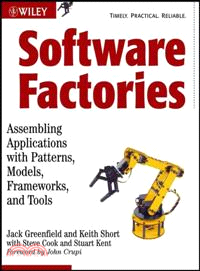Software Factories ─ Assembling Applications with Patterns,Models, Frameworks, and Tools
商品資訊
ISBN13:9780471202844
出版社:JOHN WILEY & SONS;LTD
作者:GREENFIELD
出版日:2004/09/10
裝訂/頁數:平裝/696頁
規格:23.5cm*18.4cm*2.5cm (高/寬/厚)
定價
:NT$ 1518 元優惠價
:90 折 1366 元
絕版無法訂購
商品簡介
作者簡介
目次
相關商品
商品簡介
The architects of the Software Factories method provide a detailed look at this faster, less expensive, and more reliable approach to application development. Software Factories significantly increase the level of automation in application development at medium to large companies, applying the time tested pattern of using visual languages to enable rapid assembly and configuration of framework based components.Unlike other approaches to Model Driven Development (MDD), such as Model Driven Architecture (MDA) from the Object Management Group (OMG), Software Factories do not use the Unified Modeling Language (UML), a general purpose modeling language designed for models used as documentation. They go beyond models as documentation, using models based on highly tuned Domain Specific Languages (DSLs) and the Extensible Markup Language (XML) as source artifacts, to capture life cycle metadata, and to support high fidelity model transformation, code generation and other forms of automation.
Building business applications is currently an extremely labor-intensive process that relies on a limited pool of highly talented developers. As global demand for software exceeds the capacity of this labor pool, current software development methods will be replaced by automated methods, meaning cheaper, faster, and more reliable application development. Wiley Computer Publishing has teamed with industry experts Jack Greenfield and Keith Short, both architects in the Enterprise Frameworks and Tools group at Microsoft, and leading authorities on Model Driven Development (MDD), to help technical professionals understand how business application development is changing. With two chapters on Domain Specific Language (DSL) development by contributors Steve Cook and Stuart Kent, they take an in-depth look at challenges facing developers using current methods and practices, and critical innovations that can help with these challenges, such as Pattern Automation, Generative Programming, Software Product Lines, Aspect Oriented Programming (AOP), Component Based Development (CBD), Service Oriented Architectures (SOA), Service Orchestration and Web Service Integration. They then propose the Software Factories method, which has the potential to significantly change software development practice, by reducing the cost of building reusable assets, such as patterns, languages, frameworks and tools, for specific problem domains, and then applying them to accelerate the assembly of applications in those domains.
After introducing Software Factories, the book describes these key enabling technologies in depth, and shows how they can be integrated and applied to support a form of Rapid Application Development (RAD). It then provides a detailed example of a working Software Factory and answers Frequently Asked Questions (FAQs). Readers will gain a better understanding of these technologies, and will learn how to apply them to implement Software Factories within their own organizations.
Building business applications is currently an extremely labor-intensive process that relies on a limited pool of highly talented developers. As global demand for software exceeds the capacity of this labor pool, current software development methods will be replaced by automated methods, meaning cheaper, faster, and more reliable application development. Wiley Computer Publishing has teamed with industry experts Jack Greenfield and Keith Short, both architects in the Enterprise Frameworks and Tools group at Microsoft, and leading authorities on Model Driven Development (MDD), to help technical professionals understand how business application development is changing. With two chapters on Domain Specific Language (DSL) development by contributors Steve Cook and Stuart Kent, they take an in-depth look at challenges facing developers using current methods and practices, and critical innovations that can help with these challenges, such as Pattern Automation, Generative Programming, Software Product Lines, Aspect Oriented Programming (AOP), Component Based Development (CBD), Service Oriented Architectures (SOA), Service Orchestration and Web Service Integration. They then propose the Software Factories method, which has the potential to significantly change software development practice, by reducing the cost of building reusable assets, such as patterns, languages, frameworks and tools, for specific problem domains, and then applying them to accelerate the assembly of applications in those domains.
After introducing Software Factories, the book describes these key enabling technologies in depth, and shows how they can be integrated and applied to support a form of Rapid Application Development (RAD). It then provides a detailed example of a working Software Factory and answers Frequently Asked Questions (FAQs). Readers will gain a better understanding of these technologies, and will learn how to apply them to implement Software Factories within their own organizations.
作者簡介
JACK GREENFIELD (Redmond, WA) is an Architect for Visual Studio Team System. He is an author, frequent speaker, and key contributor to component, model, and pattern technologies at Microsoft.
KEITH SHORT (Redmond, WA) is an Architect for Visual Studio Team System. He is responsible for strategy and architecture for enterprise tools at Microsoft.
STEVE COOK (Canterbury, UK) is an Architect for Visual Studio Team System. He was formerly an IBM Distinguished Engineer and a major contributor to UML and UML2.
STUART KENT (Bishop's Stortford, UK) is a Program Manager for Visual Studio Team System. He focuses on modeling technology and is an internationally recognized authority on UML.
KEITH SHORT (Redmond, WA) is an Architect for Visual Studio Team System. He is responsible for strategy and architecture for enterprise tools at Microsoft.
STEVE COOK (Canterbury, UK) is an Architect for Visual Studio Team System. He was formerly an IBM Distinguished Engineer and a major contributor to UML and UML2.
STUART KENT (Bishop's Stortford, UK) is a Program Manager for Visual Studio Team System. He focuses on modeling technology and is an internationally recognized authority on UML.
目次
Preface.
Acknowledgments.
Foreword.
Part I: Introduction to Software Factories.
Chapter 1: Introduction.
Chapter 2: Dealing with Complexity.
Chapter 3: Dealing with Change.
Chapter 4: Paradigm Shift.
Chapter 5: Software Factories.
Part II: Critical Innovations.
Chapter 6: Models and Patterns.
Chapter 7: Programming with Models.
Chapter 8: Language Anatomy.
Chapter 9: Families of Languages.
Chapter 10: Systematic Reuse.
Chapter 11: Software Product Lines.
Chapter 12: Platform-Based Abstractions.
Chapter 13: Components and Services.
Chapter 14: Mappings and Transformations.
Chapter 15: Generating Implementations.
Part III: Software Factories in Depth.
Chapter 16: A Software Factory Example.
Chapter 17: Frequently Asked Questions.
Appendix A: Abstraction and Refinement.
Appendix B: The Unified Modeling Language.
Bibliography.
Index.
Acknowledgments.
Foreword.
Part I: Introduction to Software Factories.
Chapter 1: Introduction.
Chapter 2: Dealing with Complexity.
Chapter 3: Dealing with Change.
Chapter 4: Paradigm Shift.
Chapter 5: Software Factories.
Part II: Critical Innovations.
Chapter 6: Models and Patterns.
Chapter 7: Programming with Models.
Chapter 8: Language Anatomy.
Chapter 9: Families of Languages.
Chapter 10: Systematic Reuse.
Chapter 11: Software Product Lines.
Chapter 12: Platform-Based Abstractions.
Chapter 13: Components and Services.
Chapter 14: Mappings and Transformations.
Chapter 15: Generating Implementations.
Part III: Software Factories in Depth.
Chapter 16: A Software Factory Example.
Chapter 17: Frequently Asked Questions.
Appendix A: Abstraction and Refinement.
Appendix B: The Unified Modeling Language.
Bibliography.
Index.
主題書展
更多
主題書展
更多書展今日66折
您曾經瀏覽過的商品
購物須知
外文書商品之書封,為出版社提供之樣本。實際出貨商品,以出版社所提供之現有版本為主。部份書籍,因出版社供應狀況特殊,匯率將依實際狀況做調整。
無庫存之商品,在您完成訂單程序之後,將以空運的方式為你下單調貨。為了縮短等待的時間,建議您將外文書與其他商品分開下單,以獲得最快的取貨速度,平均調貨時間為1~2個月。
為了保護您的權益,「三民網路書店」提供會員七日商品鑑賞期(收到商品為起始日)。
若要辦理退貨,請在商品鑑賞期內寄回,且商品必須是全新狀態與完整包裝(商品、附件、發票、隨貨贈品等)否則恕不接受退貨。
























